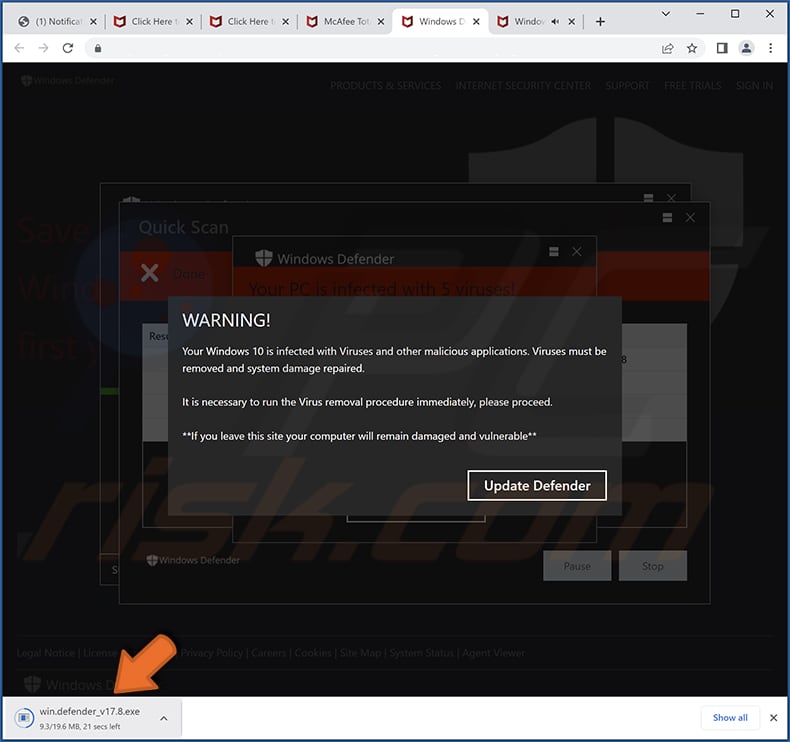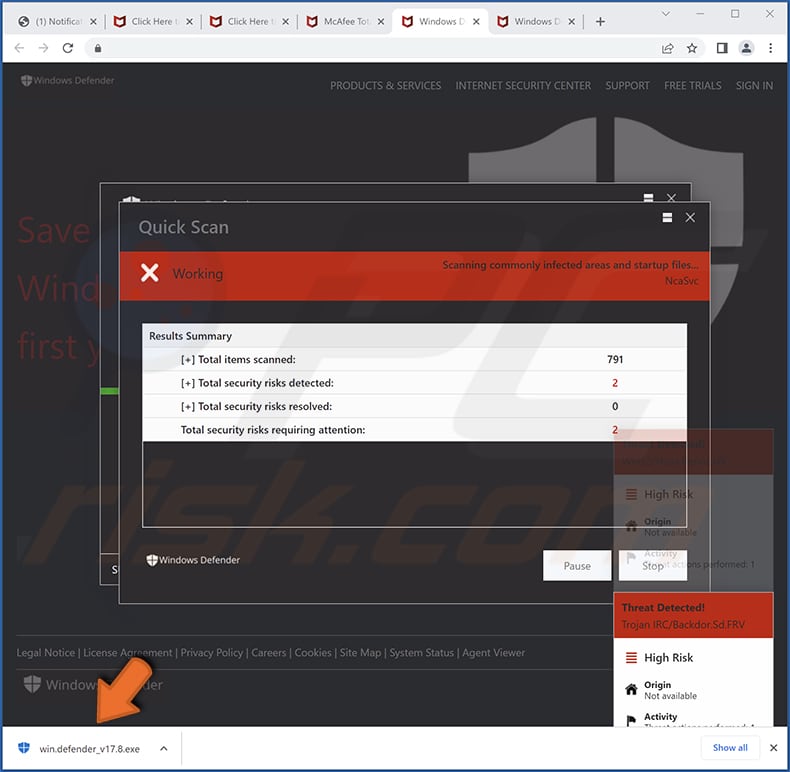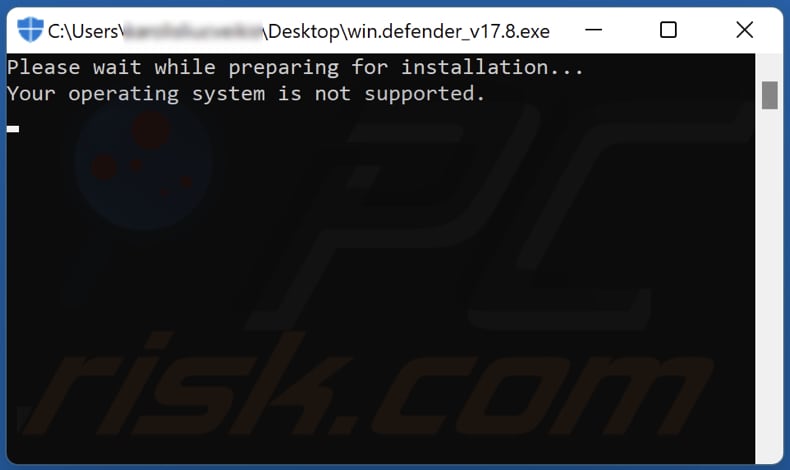How to spot scams like "Update Windows Defender"
Phishing/ScamAlso Known As: Update Windows Defender scam
Get free scan and check if your device is infected.
Remove it nowTo use full-featured product, you have to purchase a license for Combo Cleaner. Seven days free trial available. Combo Cleaner is owned and operated by RCS LT, the parent company of PCRisk.com.
What kind of scam is "Update Windows Defender"?
While examining suspicious pages, we found another page of this kind running a pop-up scam. This site uses a scare tactic to distribute malware. Its purpose is to lure unsuspecting visitors into believing that their computers are infected and executing a downloaded malicious file.

"Update Windows Defender" scam in detail
After inspecting this page, we learned that it runs a fake system scan which supposedly detects viruses on computers. It shows a fake warning from Windows claiming that a computer is infected with viruses and other malicious applications and urging to remove them.
This site is designed to download (after clicking the "Update Defender" button) an executable file named "win.defender_v17.8.exe" (its name may vary). Executing this file infects a computer with malware. The type of malware distributed via that file is unknown. It could infect a computer with ransomware, a cryptocurrency miner, Remote Administration Trojan, information-stealing (or other) Trojan.
Ransomware is malware that encrypts files to keep them inaccessible until a ransom is paid. Threat actors use ransomware to extort money from victims. Remote Administration Trojan (RAT) is malware that allows attackers to control computers remotely. Usually, RATs are used to access files, steal sensitive information, distribute malware, etc.
Cryptocurrency miner uses computer hardware to mine cryptocurrency. Usually, it causes high CPU and (or) GPU usage, system crashes, loss of unsaved data, etc. Computers infected with cryptocurrency miners consume more power, meaning victims receive higher electricity bills.
Information stealers can be designed to exfiltrate passwords, credit card details, clipboard data, data from installed apps, and other information. Cybercriminals use info-stealing malware to gain data enabling them to steal identities, hijack online accounts, make fraudulent purchases and transactions, etc.
| Name | Update Windows Defender scam |
| Threat Type | Phishing, Scam, Social Engineering, Fraud |
| Fake Claim | A computer is infected with viruses and other malicious applications |
| Disguise | Legitimate warning from Windows |
| Distributed File/Malicious Installer | win.defender_v17.8.exe |
| Detection Names (win.defender_v17.8.exe) | Acronis (Suspicious), Avira (HEUR/AGEN.1231945), Elastic (Malicious (moderate Confidence)), F-Secure (Heuristic.HEUR/AGEN.1231945), Trellix (Generic.mg.b50284f6df2fa950), Full List Of Detections (VirusTotal) |
| Related Domain | safepcone[.]xyz |
| Detection Names (safepcone[.]xyz) | Forcepoint ThreatSeeker (Suspicious), (VirusTotal) |
| Serving IP Address (safepcone[.]xyz) | 5.101.181.22 |
| Symptoms | Fake error messages, fake system warnings, pop-up errors, hoax computer scan. |
| Distribution methods | Compromised websites, rogue online pop-up ads, unwanted applications. |
| Damage | Loss of sensitive private information, monetary loss, identity theft, possible malware infections. |
| Malware Removal (Windows) |
To eliminate possible malware infections, scan your computer with legitimate antivirus software. Our security researchers recommend using Combo Cleaner. Download Combo CleanerTo use full-featured product, you have to purchase a license for Combo Cleaner. 7 days free trial available. Combo Cleaner is owned and operated by RCS LT, the parent company of PCRisk.com. |
Online scams in general
Websites that show fake virus alerts, system warnings, error notifications, etc., use scare tactics to trick visitors into performing certain actions. Cybercriminals use them to trick visitors into downloading malware, providing remote access to computers, providing sensitive information, paying for fake or unnecessary services or products, etc.
Examples of similar scams are "Avira - Your System Was Corrupted", "Your Windows Got Corrupted Due To Virus", and "Windows Firewall Has Detected That Your Windows Is Damaged And Irrelevant".
How did I open a scam website
Users open these pages by clicking on untrustworthy advertisements, visiting websites that use rogue advertising networks, clicking on notifications delivered by shady websites, etc. Also, these pages can be opened by installed adware. Either way, it is uncommon for pages running pop-up scams to be visited intentionally.
Do not trust advertisements on torrent sites, illegal movie streaming pages, and other websites of this kind. The same applies to pop-ups offering to download software. Always download software from official pages and stores. Do not use P2P networks, free file hosting pages, third-party downloaders, etc., to download apps.
How to avoid visiting scam pages?
Never agree to receive notifications from suspicious websites (especially from pages instructing you to click the "Allow" button to perform certain actions). If your computer is already infected with unwanted apps, we recommend running a scan with Combo Cleaner Antivirus for Windows to automatically eliminate them.
Text presented in the fake Windows message (pop-up window):
WARNING!
Your Windows 10 is infected with Viruses and other malicious applications. Viruses must be removed and system damage repaired.
It is necessary to run the Virus removal procedure immediately, please proceed.
**If you leave this site your computer will remain damaged and vulnerable**
[Update Defender]
Screenshot of a fake scanner displayed by this page:

Screenshot of the window that pops up after executing the downloaded malicious installer:

Instant automatic malware removal:
Manual threat removal might be a lengthy and complicated process that requires advanced IT skills. Combo Cleaner is a professional automatic malware removal tool that is recommended to get rid of malware. Download it by clicking the button below:
DOWNLOAD Combo CleanerBy downloading any software listed on this website you agree to our Privacy Policy and Terms of Use. To use full-featured product, you have to purchase a license for Combo Cleaner. 7 days free trial available. Combo Cleaner is owned and operated by RCS LT, the parent company of PCRisk.com.
Quick menu:
- What is Update Windows Defender scam?
- How to identify a pop-up scam?
- How do pop-up scams work?
- How to remove fake pop-ups?
- How to prevent fake pop-ups?
- What to do if you fell for a pop-up scam?
How to identify a pop-up scam?
Pop-up windows with various fake messages are a common type of lures cybercriminals use. They collect sensitive personal data, trick Internet users into calling fake tech support numbers, subscribe to useless online services, invest in shady cryptocurrency schemes, etc.
While in the majority of cases these pop-ups don't infect users' devices with malware, they can cause direct monetary loss or could result in identity theft.
Cybercriminals strive to create their rogue pop-up windows to look trustworthy, however, scams typically have the following characteristics:
- Spelling mistakes and non-professional images - Closely inspect the information displayed in a pop-up. Spelling mistakes and unprofessional images could be a sign of a scam.
- Sense of urgency - Countdown timer with a couple of minutes on it, asking you to enter your personal information or subscribe to some online service.
- Statements that you won something - If you haven't participated in a lottery, online competition, etc., and you see a pop-up window stating that you won.
- Computer or mobile device scan - A pop-up window that scans your device and informs of detected issues - is undoubtedly a scam; webpages cannot perform such actions.
- Exclusivity - Pop-up windows stating that only you are given secret access to a financial scheme that can quickly make you rich.
Example of a pop-up scam:

How do pop-up scams work?
Cybercriminals and deceptive marketers usually use various advertising networks, search engine poisoning techniques, and shady websites to generate traffic to their pop-ups. Users land on their online lures after clicking on fake download buttons, using a torrent website, or simply clicking on an Internet search engine result.
Based on users' location and device information, they are presented with a scam pop-up. Lures presented in such pop-ups range from get-rich-quick schemes to fake virus scans.
How to remove fake pop-ups?
In most cases, pop-up scams do not infect users' devices with malware. If you encountered a scam pop-up, simply closing it should be enough. In some cases scam, pop-ups may be hard to close; in such cases - close your Internet browser and restart it.
In extremely rare cases, you might need to reset your Internet browser. For this, use our instructions explaining how to reset Internet browser settings.
How to prevent fake pop-ups?
To prevent seeing pop-up scams, you should visit only reputable websites. Torrent, Crack, free online movie streaming, YouTube video download, and other websites of similar reputation commonly redirect Internet users to pop-up scams.
To minimize the risk of encountering pop-up scams, you should keep your Internet browsers up-to-date and use reputable anti-malware application. For this purpose, we recommend Combo Cleaner Antivirus for Windows.
What to do if you fell for a pop-up scam?
This depends on the type of scam that you fell for. Most commonly, pop-up scams try to trick users into sending money, giving away personal information, or giving access to one's device.
- If you sent money to scammers: You should contact your financial institution and explain that you were scammed. If informed promptly, there's a chance to get your money back.
- If you gave away your personal information: You should change your passwords and enable two-factor authentication in all online services that you use. Visit Federal Trade Commission to report identity theft and get personalized recovery steps.
- If you let scammers connect to your device: You should scan your computer with reputable anti-malware (we recommend Combo Cleaner Antivirus for Windows) - cyber criminals could have planted trojans, keyloggers, and other malware, don't use your computer until removing possible threats.
- Help other Internet users: report Internet scams to Federal Trade Commission.
Frequently Asked Questions (FAQ)
What is a pop-up scam?
It is a fake message (e.g., a fake virus warning) displayed by an untrustworthy website. Scammers behind websites running pop-up scams aim to trick visitors into performing certain actions.
What is the purpose of a pop-up scam?
Scammers use pop-up scams to trick visitors into granting remote access to their computers, downloading malware, providing sensitive information, transferring money, etc.
Why do I encounter fake pop-ups?
These pop-ups are displayed by shady pages that are promoted via shady advertisements, websites that use rogue advertising networks, adware, notifications from untrustworthy websites, etc.
Will Combo Cleaner protect me from pop-up scams?
Combo Cleaner is designed to scan websites and detect untrustworthy ones, including websites that show deceptive pop-ups. Thus, Combo Cleaner will warn you about pages of this kind and restrict access to them.
Share:

Tomas Meskauskas
Expert security researcher, professional malware analyst
I am passionate about computer security and technology. I have an experience of over 10 years working in various companies related to computer technical issue solving and Internet security. I have been working as an author and editor for pcrisk.com since 2010. Follow me on Twitter and LinkedIn to stay informed about the latest online security threats.
PCrisk security portal is brought by a company RCS LT.
Joined forces of security researchers help educate computer users about the latest online security threats. More information about the company RCS LT.
Our malware removal guides are free. However, if you want to support us you can send us a donation.
DonatePCrisk security portal is brought by a company RCS LT.
Joined forces of security researchers help educate computer users about the latest online security threats. More information about the company RCS LT.
Our malware removal guides are free. However, if you want to support us you can send us a donation.
Donate
▼ Show Discussion